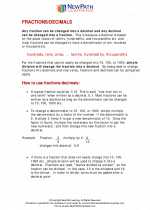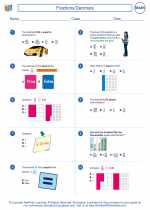Fractions/Decimals -> common denominator
Common Denominator Study Guide
What is a Common Denominator?
A common denominator is a shared multiple of the denominators of two or more fractions. When adding or subtracting fractions, it is important to have a common denominator in order to perform the operation.
Finding a Common Denominator
To find a common denominator for two or more fractions, you can follow these steps:
- List the multiples of each denominator until you find a common multiple.
- Identify the least common multiple (LCM) as the smallest common multiple found.
- Use the LCM as the common denominator for the fractions.
Example:
Find the common denominator for the fractions 1/3 and 2/5.
We start by listing the multiples of 3 and 5:
Multiples of 3: 3, 6, 9, 12, 15, 18, 21, 24, 27, 30, ...
Multiples of 5: 5, 10, 15, 20, 25, 30, ...
The common multiples are 15 and 30. The least common multiple is 15.
So, the common denominator for 1/3 and 2/5 is 15.
Using the Common Denominator
Once you have found the common denominator, you can rewrite each fraction with the common denominator and then perform the operation (addition or subtraction).
Example:
Add the fractions 1/3 and 2/5 using the common denominator 15.
1/3 = 5/15 (multiplied numerator and denominator by 5 to get the common denominator)
2/5 = 6/15 (multiplied numerator and denominator by 3 to get the common denominator)
Now, we can add the fractions: 5/15 + 6/15 = 11/15
So, 1/3 + 2/5 = 11/15 when using the common denominator 15.
Practice Problems
Now that you have learned about common denominators, try these practice problems to reinforce your understanding:
- Find the common denominator for the fractions 2/7 and 3/4.
- Add the fractions 2/7 and 3/4 using the common denominator you found in the previous step.
- Find the common denominator for the fractions 1/2, 3/4, and 5/6.
- Add the fractions 1/2, 3/4, and 5/6 using the common denominator you found in the previous step.
Remember to simplify your final answers if necessary!
.◂Math Worksheets and Study Guides Sixth Grade. Fractions/Decimals

 Worksheet/Answer key
Worksheet/Answer key
 Worksheet/Answer key
Worksheet/Answer key
 Worksheet/Answer key
Worksheet/Answer key
